PurePonics: Business Model Canvas and Strategic Analysis Report
VerifiedAdded on 2021/05/31
|12
|2469
|241
Report
AI Summary
This report provides a comprehensive analysis of the PurePonics business model canvas, a startup in the Australian agriculture and farming industry that utilizes an aquaponics approach for sustainable production of vegetables and fish. The report details the key components of the business model, including key partners (farmers, retail stores), activities (R&D, aquaponics production), value propositions (natural, fresh products), customer relationships, segments (high-end, organic food consumers), resources (farmers, scientists, capital), channels (offline retail), cost structure (R&D, equipment), and revenue streams (organic vegetable and seafood sales). It explores the interrelationships between these factors, identifying critical success factors such as market expansion and online sales, as well as potential risks like premium pricing and competition. The report concludes with recommendations, including changes to retail marketing and expansion into e-commerce, offering insights into PurePonics' strategic approach and future prospects.
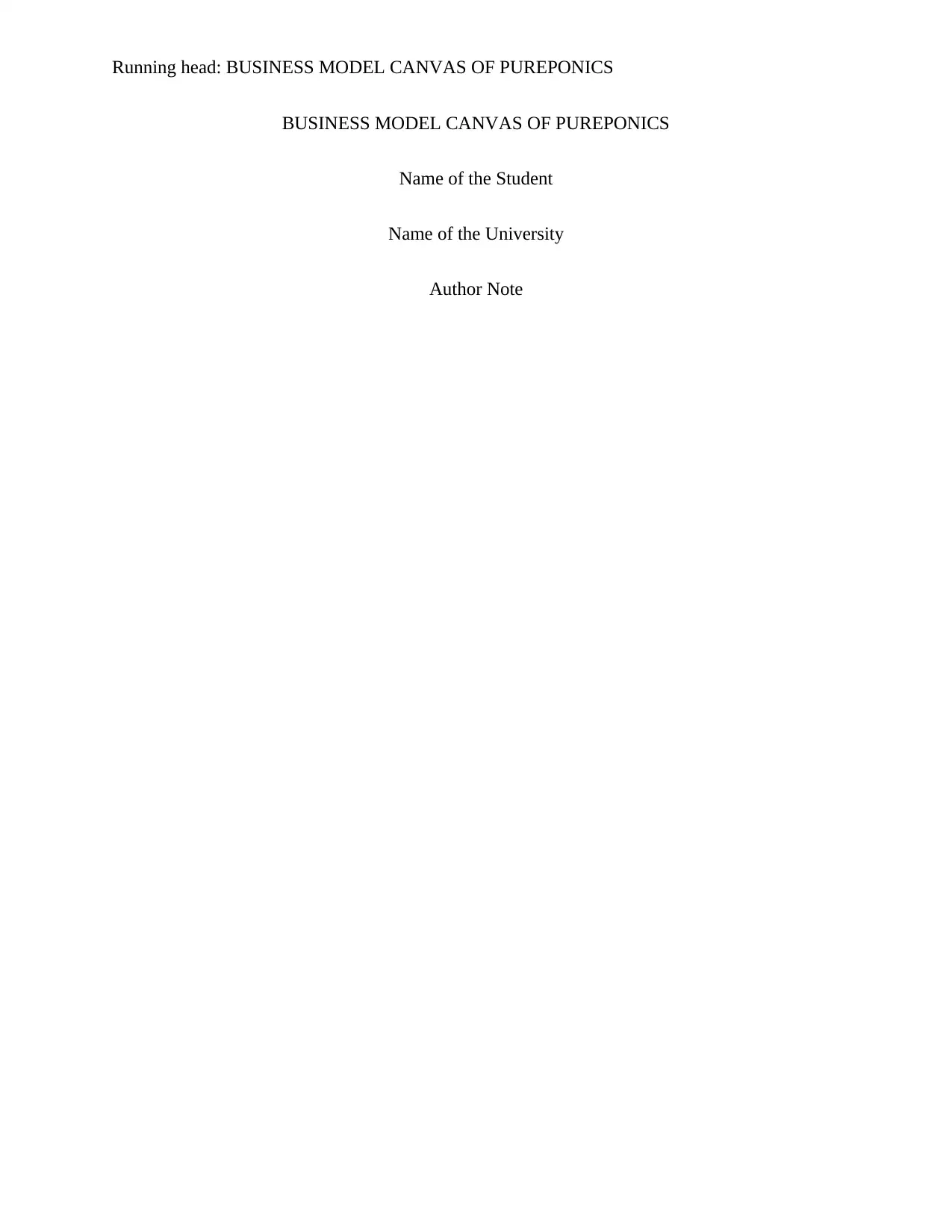
Running head: BUSINESS MODEL CANVAS OF PUREPONICS
BUSINESS MODEL CANVAS OF PUREPONICS
Name of the Student
Name of the University
Author Note
BUSINESS MODEL CANVAS OF PUREPONICS
Name of the Student
Name of the University
Author Note
Paraphrase This Document
Need a fresh take? Get an instant paraphrase of this document with our AI Paraphraser
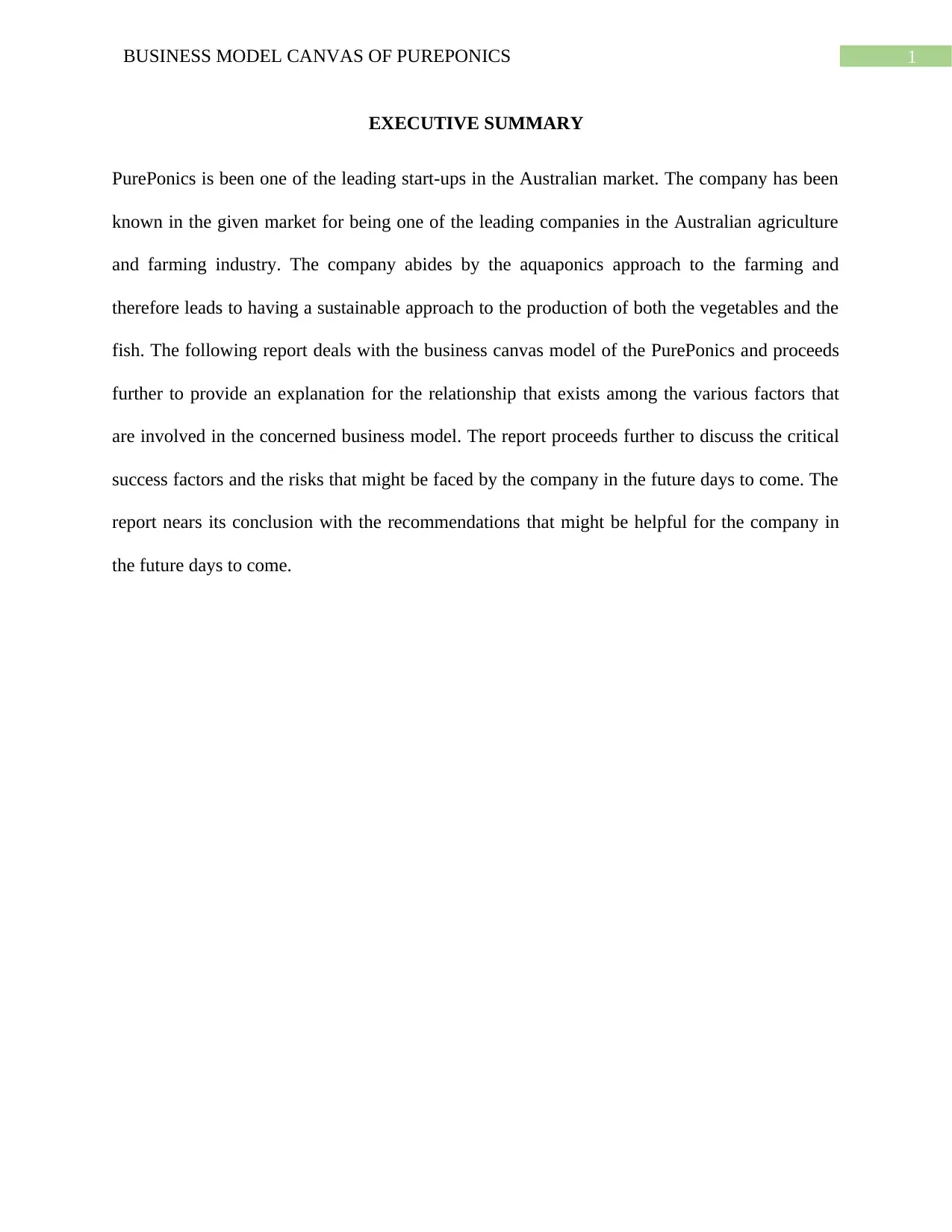
1BUSINESS MODEL CANVAS OF PUREPONICS
EXECUTIVE SUMMARY
PurePonics is been one of the leading start-ups in the Australian market. The company has been
known in the given market for being one of the leading companies in the Australian agriculture
and farming industry. The company abides by the aquaponics approach to the farming and
therefore leads to having a sustainable approach to the production of both the vegetables and the
fish. The following report deals with the business canvas model of the PurePonics and proceeds
further to provide an explanation for the relationship that exists among the various factors that
are involved in the concerned business model. The report proceeds further to discuss the critical
success factors and the risks that might be faced by the company in the future days to come. The
report nears its conclusion with the recommendations that might be helpful for the company in
the future days to come.
EXECUTIVE SUMMARY
PurePonics is been one of the leading start-ups in the Australian market. The company has been
known in the given market for being one of the leading companies in the Australian agriculture
and farming industry. The company abides by the aquaponics approach to the farming and
therefore leads to having a sustainable approach to the production of both the vegetables and the
fish. The following report deals with the business canvas model of the PurePonics and proceeds
further to provide an explanation for the relationship that exists among the various factors that
are involved in the concerned business model. The report proceeds further to discuss the critical
success factors and the risks that might be faced by the company in the future days to come. The
report nears its conclusion with the recommendations that might be helpful for the company in
the future days to come.
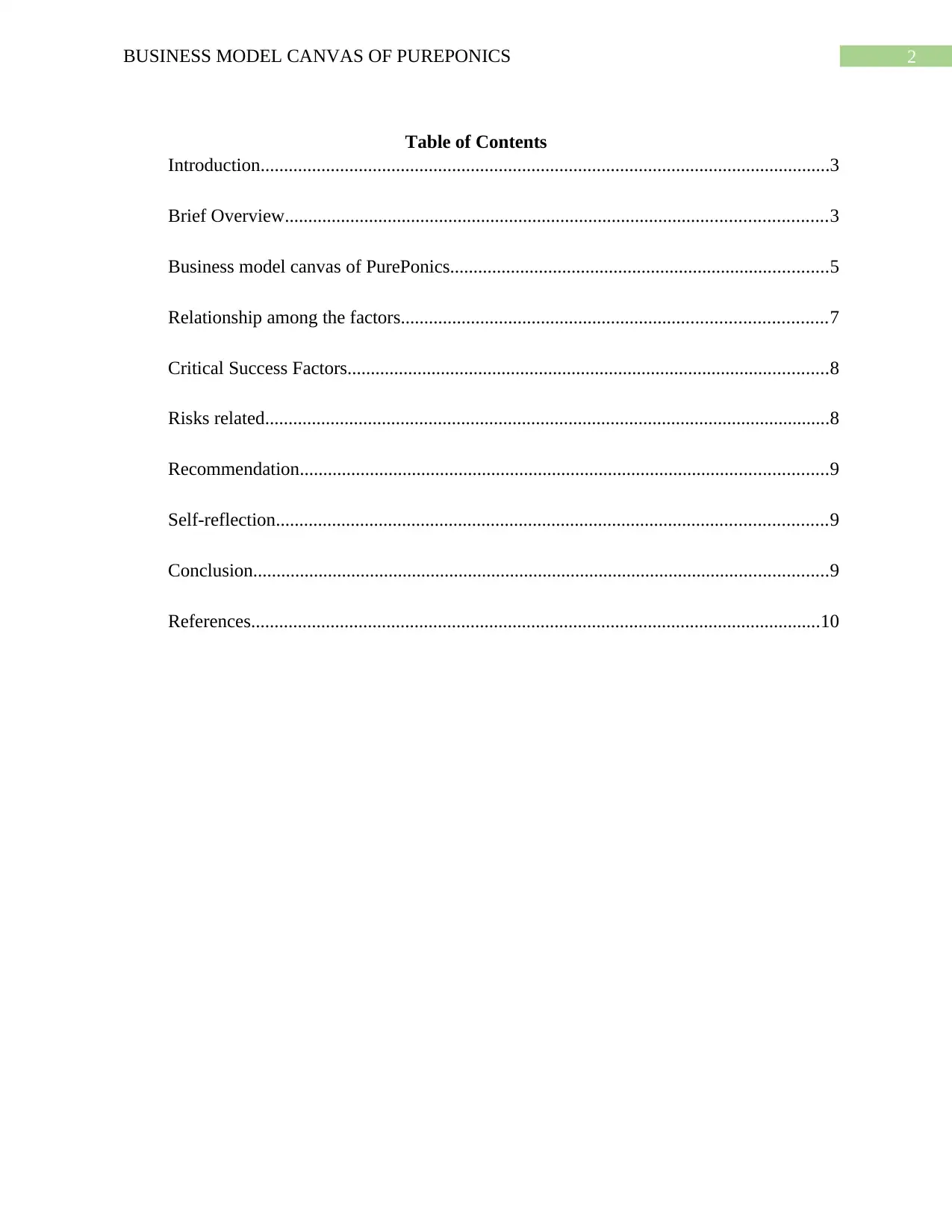
2BUSINESS MODEL CANVAS OF PUREPONICS
Table of Contents
Introduction..........................................................................................................................3
Brief Overview....................................................................................................................3
Business model canvas of PurePonics.................................................................................5
Relationship among the factors...........................................................................................7
Critical Success Factors.......................................................................................................8
Risks related.........................................................................................................................8
Recommendation.................................................................................................................9
Self-reflection......................................................................................................................9
Conclusion...........................................................................................................................9
References..........................................................................................................................10
Table of Contents
Introduction..........................................................................................................................3
Brief Overview....................................................................................................................3
Business model canvas of PurePonics.................................................................................5
Relationship among the factors...........................................................................................7
Critical Success Factors.......................................................................................................8
Risks related.........................................................................................................................8
Recommendation.................................................................................................................9
Self-reflection......................................................................................................................9
Conclusion...........................................................................................................................9
References..........................................................................................................................10
⊘ This is a preview!⊘
Do you want full access?
Subscribe today to unlock all pages.

Trusted by 1+ million students worldwide
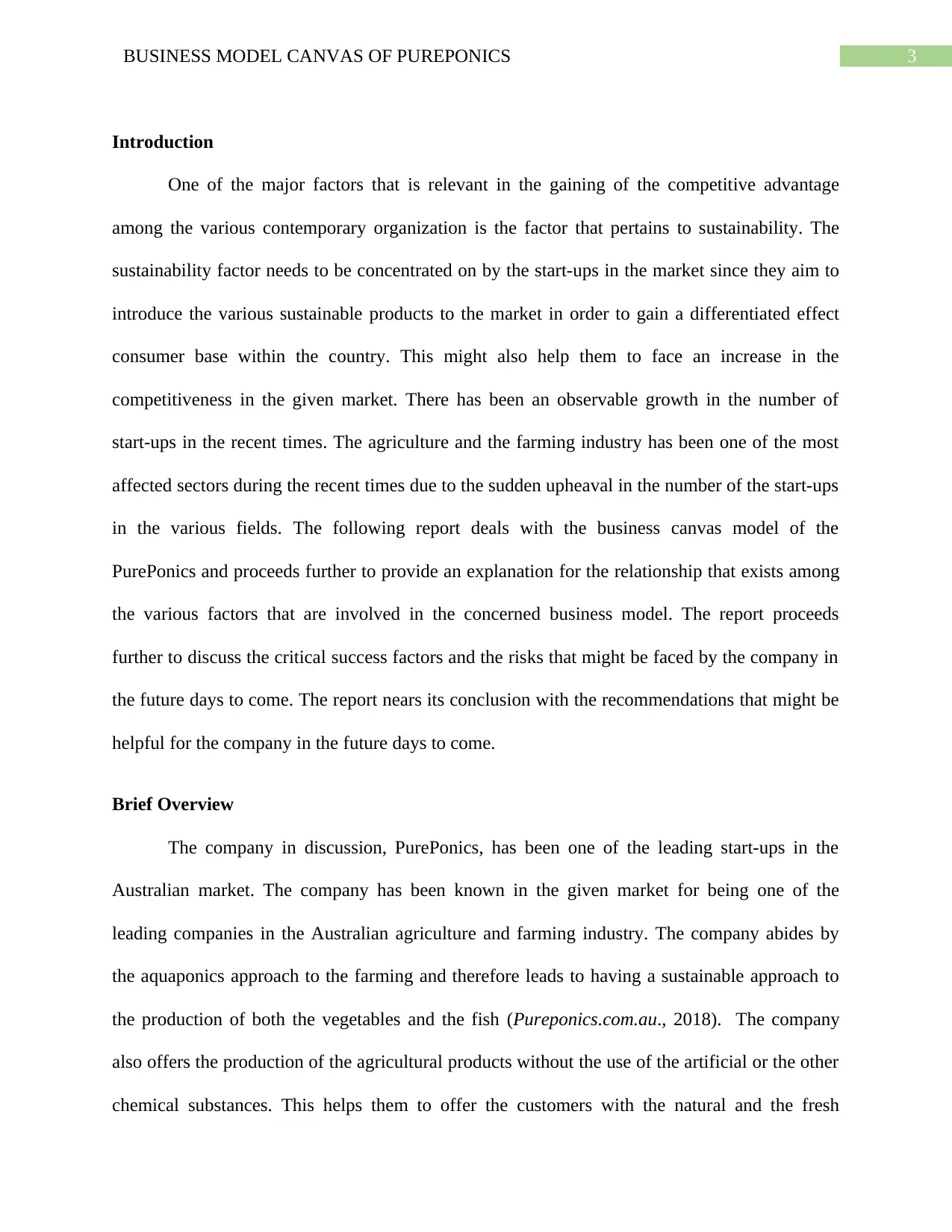
3BUSINESS MODEL CANVAS OF PUREPONICS
Introduction
One of the major factors that is relevant in the gaining of the competitive advantage
among the various contemporary organization is the factor that pertains to sustainability. The
sustainability factor needs to be concentrated on by the start-ups in the market since they aim to
introduce the various sustainable products to the market in order to gain a differentiated effect
consumer base within the country. This might also help them to face an increase in the
competitiveness in the given market. There has been an observable growth in the number of
start-ups in the recent times. The agriculture and the farming industry has been one of the most
affected sectors during the recent times due to the sudden upheaval in the number of the start-ups
in the various fields. The following report deals with the business canvas model of the
PurePonics and proceeds further to provide an explanation for the relationship that exists among
the various factors that are involved in the concerned business model. The report proceeds
further to discuss the critical success factors and the risks that might be faced by the company in
the future days to come. The report nears its conclusion with the recommendations that might be
helpful for the company in the future days to come.
Brief Overview
The company in discussion, PurePonics, has been one of the leading start-ups in the
Australian market. The company has been known in the given market for being one of the
leading companies in the Australian agriculture and farming industry. The company abides by
the aquaponics approach to the farming and therefore leads to having a sustainable approach to
the production of both the vegetables and the fish (Pureponics.com.au., 2018). The company
also offers the production of the agricultural products without the use of the artificial or the other
chemical substances. This helps them to offer the customers with the natural and the fresh
Introduction
One of the major factors that is relevant in the gaining of the competitive advantage
among the various contemporary organization is the factor that pertains to sustainability. The
sustainability factor needs to be concentrated on by the start-ups in the market since they aim to
introduce the various sustainable products to the market in order to gain a differentiated effect
consumer base within the country. This might also help them to face an increase in the
competitiveness in the given market. There has been an observable growth in the number of
start-ups in the recent times. The agriculture and the farming industry has been one of the most
affected sectors during the recent times due to the sudden upheaval in the number of the start-ups
in the various fields. The following report deals with the business canvas model of the
PurePonics and proceeds further to provide an explanation for the relationship that exists among
the various factors that are involved in the concerned business model. The report proceeds
further to discuss the critical success factors and the risks that might be faced by the company in
the future days to come. The report nears its conclusion with the recommendations that might be
helpful for the company in the future days to come.
Brief Overview
The company in discussion, PurePonics, has been one of the leading start-ups in the
Australian market. The company has been known in the given market for being one of the
leading companies in the Australian agriculture and farming industry. The company abides by
the aquaponics approach to the farming and therefore leads to having a sustainable approach to
the production of both the vegetables and the fish (Pureponics.com.au., 2018). The company
also offers the production of the agricultural products without the use of the artificial or the other
chemical substances. This helps them to offer the customers with the natural and the fresh
Paraphrase This Document
Need a fresh take? Get an instant paraphrase of this document with our AI Paraphraser
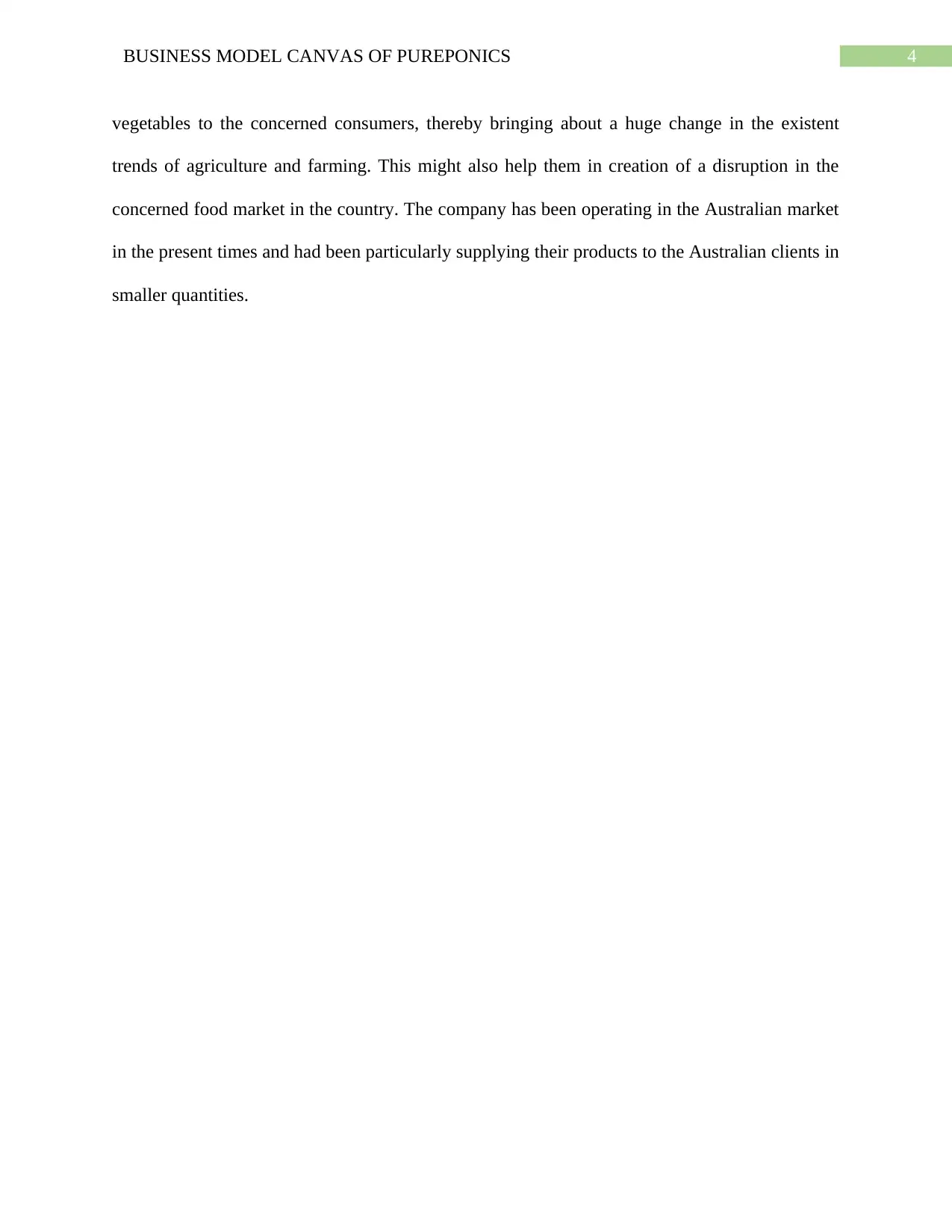
4BUSINESS MODEL CANVAS OF PUREPONICS
vegetables to the concerned consumers, thereby bringing about a huge change in the existent
trends of agriculture and farming. This might also help them in creation of a disruption in the
concerned food market in the country. The company has been operating in the Australian market
in the present times and had been particularly supplying their products to the Australian clients in
smaller quantities.
vegetables to the concerned consumers, thereby bringing about a huge change in the existent
trends of agriculture and farming. This might also help them in creation of a disruption in the
concerned food market in the country. The company has been operating in the Australian market
in the present times and had been particularly supplying their products to the Australian clients in
smaller quantities.
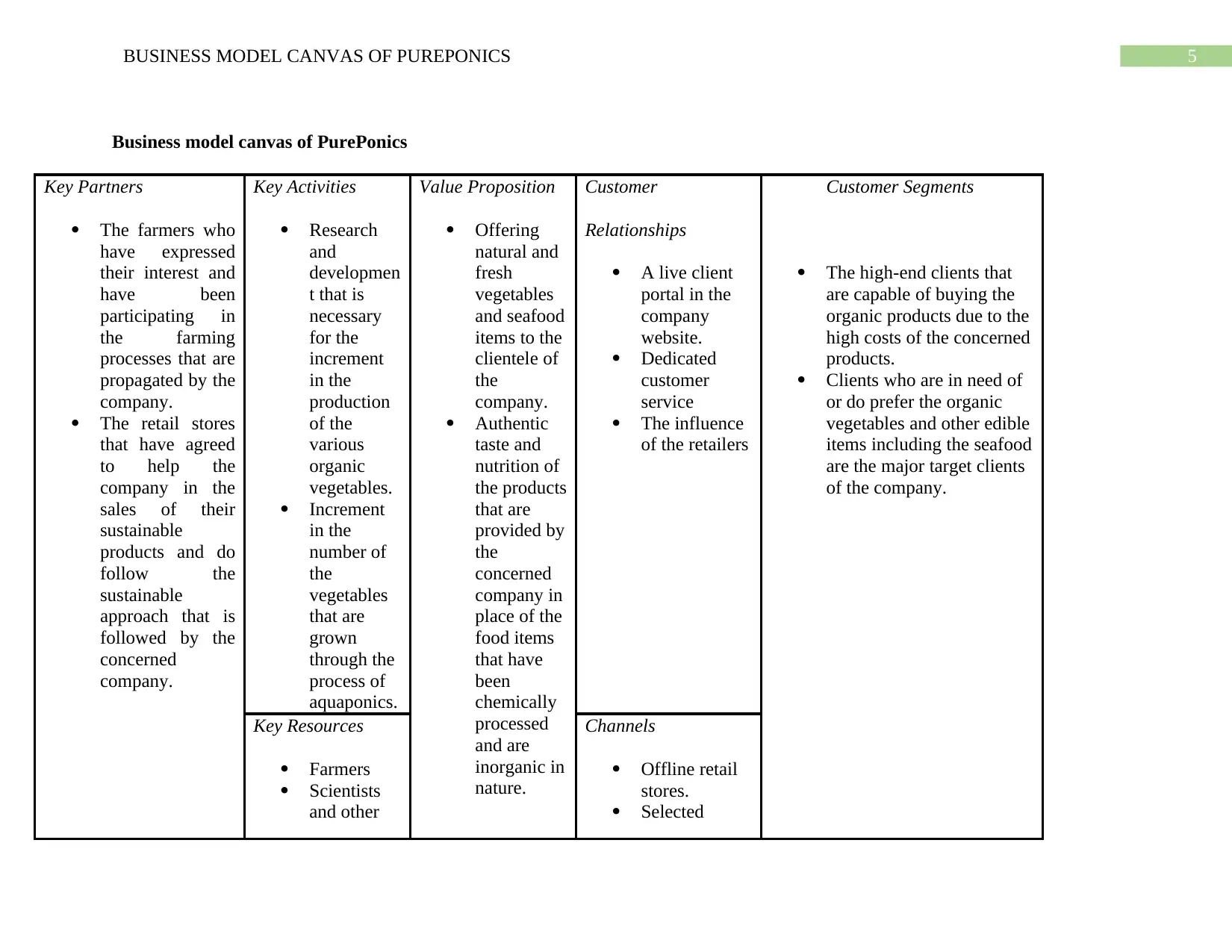
5BUSINESS MODEL CANVAS OF PUREPONICS
Business model canvas of PurePonics
Key Partners
The farmers who
have expressed
their interest and
have been
participating in
the farming
processes that are
propagated by the
company.
The retail stores
that have agreed
to help the
company in the
sales of their
sustainable
products and do
follow the
sustainable
approach that is
followed by the
concerned
company.
Key Activities
Research
and
developmen
t that is
necessary
for the
increment
in the
production
of the
various
organic
vegetables.
Increment
in the
number of
the
vegetables
that are
grown
through the
process of
aquaponics.
Value Proposition
Offering
natural and
fresh
vegetables
and seafood
items to the
clientele of
the
company.
Authentic
taste and
nutrition of
the products
that are
provided by
the
concerned
company in
place of the
food items
that have
been
chemically
processed
and are
inorganic in
nature.
Customer
Relationships
A live client
portal in the
company
website.
Dedicated
customer
service
The influence
of the retailers
Customer Segments
The high-end clients that
are capable of buying the
organic products due to the
high costs of the concerned
products.
Clients who are in need of
or do prefer the organic
vegetables and other edible
items including the seafood
are the major target clients
of the company.
Key Resources
Farmers
Scientists
and other
Channels
Offline retail
stores.
Selected
Business model canvas of PurePonics
Key Partners
The farmers who
have expressed
their interest and
have been
participating in
the farming
processes that are
propagated by the
company.
The retail stores
that have agreed
to help the
company in the
sales of their
sustainable
products and do
follow the
sustainable
approach that is
followed by the
concerned
company.
Key Activities
Research
and
developmen
t that is
necessary
for the
increment
in the
production
of the
various
organic
vegetables.
Increment
in the
number of
the
vegetables
that are
grown
through the
process of
aquaponics.
Value Proposition
Offering
natural and
fresh
vegetables
and seafood
items to the
clientele of
the
company.
Authentic
taste and
nutrition of
the products
that are
provided by
the
concerned
company in
place of the
food items
that have
been
chemically
processed
and are
inorganic in
nature.
Customer
Relationships
A live client
portal in the
company
website.
Dedicated
customer
service
The influence
of the retailers
Customer Segments
The high-end clients that
are capable of buying the
organic products due to the
high costs of the concerned
products.
Clients who are in need of
or do prefer the organic
vegetables and other edible
items including the seafood
are the major target clients
of the company.
Key Resources
Farmers
Scientists
and other
Channels
Offline retail
stores.
Selected
⊘ This is a preview!⊘
Do you want full access?
Subscribe today to unlock all pages.

Trusted by 1+ million students worldwide
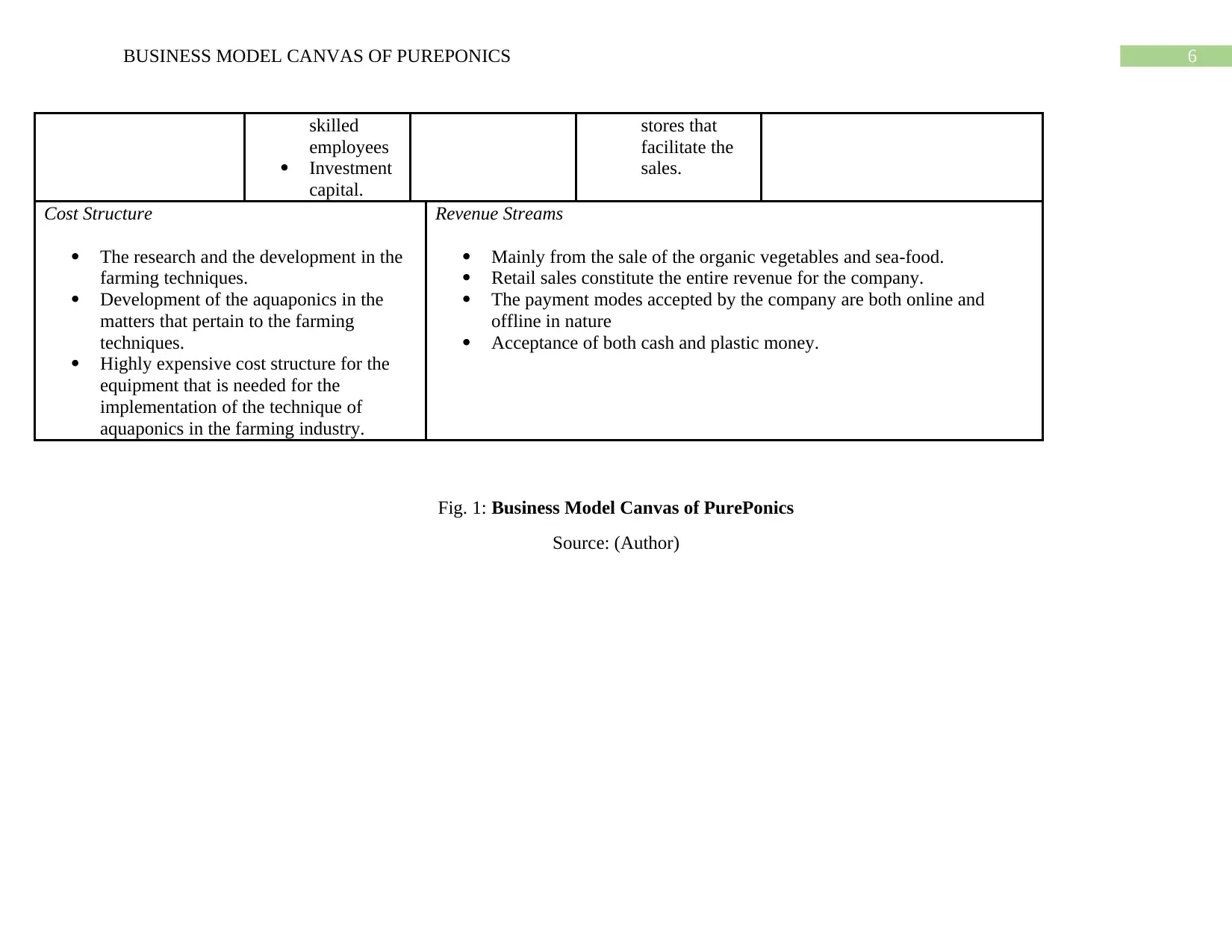
6BUSINESS MODEL CANVAS OF PUREPONICS
skilled
employees
Investment
capital.
stores that
facilitate the
sales.
Cost Structure
The research and the development in the
farming techniques.
Development of the aquaponics in the
matters that pertain to the farming
techniques.
Highly expensive cost structure for the
equipment that is needed for the
implementation of the technique of
aquaponics in the farming industry.
Revenue Streams
Mainly from the sale of the organic vegetables and sea-food.
Retail sales constitute the entire revenue for the company.
The payment modes accepted by the company are both online and
offline in nature
Acceptance of both cash and plastic money.
Fig. 1: Business Model Canvas of PurePonics
Source: (Author)
skilled
employees
Investment
capital.
stores that
facilitate the
sales.
Cost Structure
The research and the development in the
farming techniques.
Development of the aquaponics in the
matters that pertain to the farming
techniques.
Highly expensive cost structure for the
equipment that is needed for the
implementation of the technique of
aquaponics in the farming industry.
Revenue Streams
Mainly from the sale of the organic vegetables and sea-food.
Retail sales constitute the entire revenue for the company.
The payment modes accepted by the company are both online and
offline in nature
Acceptance of both cash and plastic money.
Fig. 1: Business Model Canvas of PurePonics
Source: (Author)
Paraphrase This Document
Need a fresh take? Get an instant paraphrase of this document with our AI Paraphraser
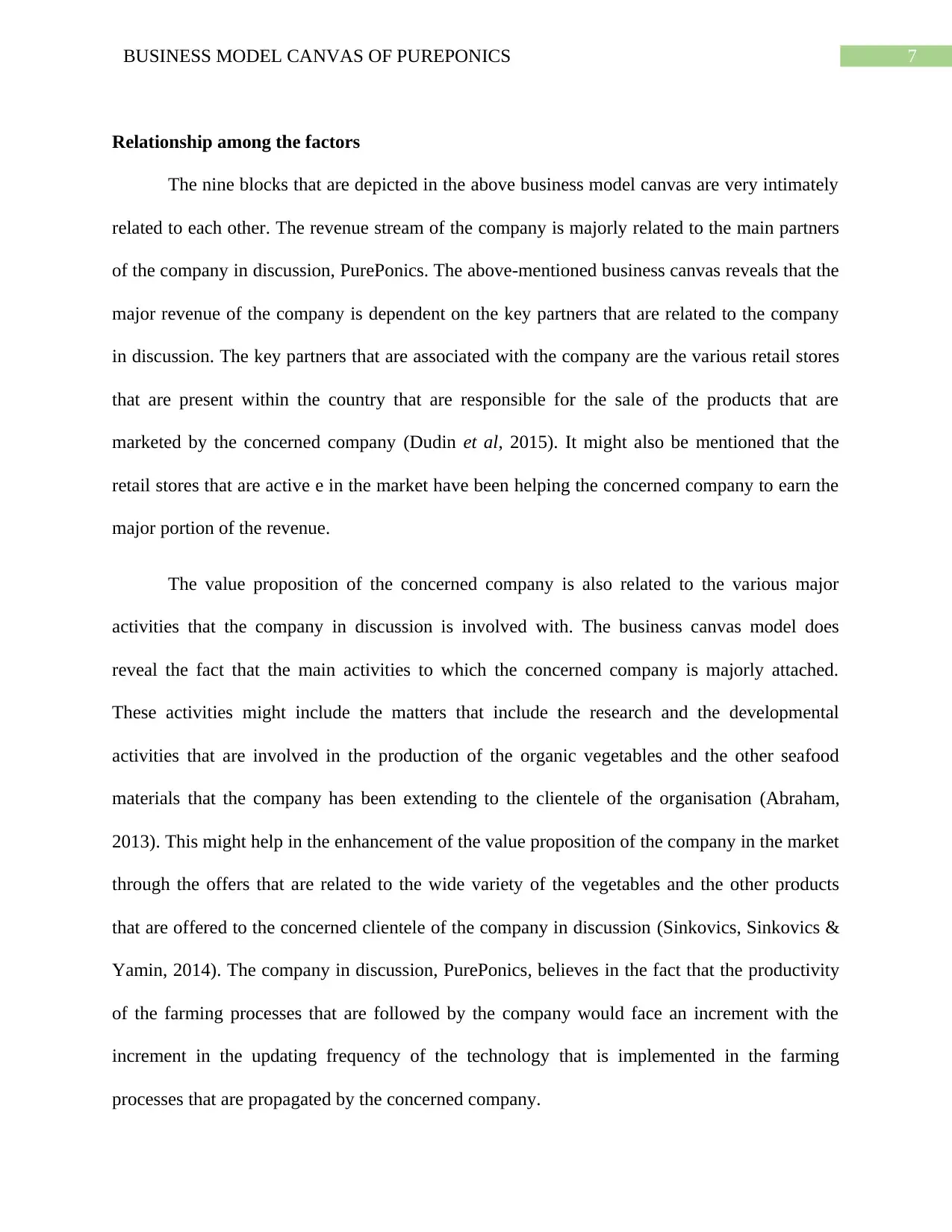
7BUSINESS MODEL CANVAS OF PUREPONICS
Relationship among the factors
The nine blocks that are depicted in the above business model canvas are very intimately
related to each other. The revenue stream of the company is majorly related to the main partners
of the company in discussion, PurePonics. The above-mentioned business canvas reveals that the
major revenue of the company is dependent on the key partners that are related to the company
in discussion. The key partners that are associated with the company are the various retail stores
that are present within the country that are responsible for the sale of the products that are
marketed by the concerned company (Dudin et al, 2015). It might also be mentioned that the
retail stores that are active e in the market have been helping the concerned company to earn the
major portion of the revenue.
The value proposition of the concerned company is also related to the various major
activities that the company in discussion is involved with. The business canvas model does
reveal the fact that the main activities to which the concerned company is majorly attached.
These activities might include the matters that include the research and the developmental
activities that are involved in the production of the organic vegetables and the other seafood
materials that the company has been extending to the clientele of the organisation (Abraham,
2013). This might help in the enhancement of the value proposition of the company in the market
through the offers that are related to the wide variety of the vegetables and the other products
that are offered to the concerned clientele of the company in discussion (Sinkovics, Sinkovics &
Yamin, 2014). The company in discussion, PurePonics, believes in the fact that the productivity
of the farming processes that are followed by the company would face an increment with the
increment in the updating frequency of the technology that is implemented in the farming
processes that are propagated by the concerned company.
Relationship among the factors
The nine blocks that are depicted in the above business model canvas are very intimately
related to each other. The revenue stream of the company is majorly related to the main partners
of the company in discussion, PurePonics. The above-mentioned business canvas reveals that the
major revenue of the company is dependent on the key partners that are related to the company
in discussion. The key partners that are associated with the company are the various retail stores
that are present within the country that are responsible for the sale of the products that are
marketed by the concerned company (Dudin et al, 2015). It might also be mentioned that the
retail stores that are active e in the market have been helping the concerned company to earn the
major portion of the revenue.
The value proposition of the concerned company is also related to the various major
activities that the company in discussion is involved with. The business canvas model does
reveal the fact that the main activities to which the concerned company is majorly attached.
These activities might include the matters that include the research and the developmental
activities that are involved in the production of the organic vegetables and the other seafood
materials that the company has been extending to the clientele of the organisation (Abraham,
2013). This might help in the enhancement of the value proposition of the company in the market
through the offers that are related to the wide variety of the vegetables and the other products
that are offered to the concerned clientele of the company in discussion (Sinkovics, Sinkovics &
Yamin, 2014). The company in discussion, PurePonics, believes in the fact that the productivity
of the farming processes that are followed by the company would face an increment with the
increment in the updating frequency of the technology that is implemented in the farming
processes that are propagated by the concerned company.
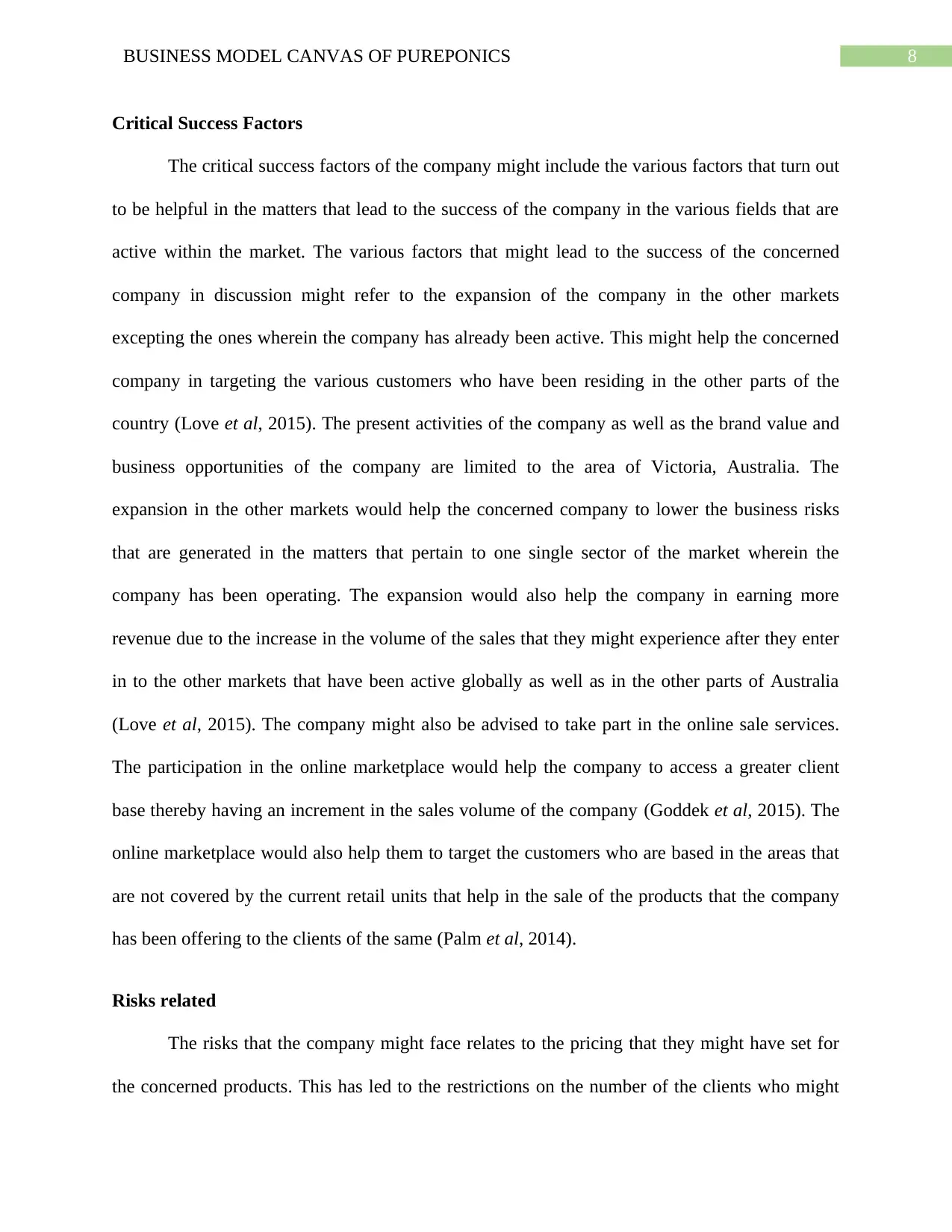
8BUSINESS MODEL CANVAS OF PUREPONICS
Critical Success Factors
The critical success factors of the company might include the various factors that turn out
to be helpful in the matters that lead to the success of the company in the various fields that are
active within the market. The various factors that might lead to the success of the concerned
company in discussion might refer to the expansion of the company in the other markets
excepting the ones wherein the company has already been active. This might help the concerned
company in targeting the various customers who have been residing in the other parts of the
country (Love et al, 2015). The present activities of the company as well as the brand value and
business opportunities of the company are limited to the area of Victoria, Australia. The
expansion in the other markets would help the concerned company to lower the business risks
that are generated in the matters that pertain to one single sector of the market wherein the
company has been operating. The expansion would also help the company in earning more
revenue due to the increase in the volume of the sales that they might experience after they enter
in to the other markets that have been active globally as well as in the other parts of Australia
(Love et al, 2015). The company might also be advised to take part in the online sale services.
The participation in the online marketplace would help the company to access a greater client
base thereby having an increment in the sales volume of the company (Goddek et al, 2015). The
online marketplace would also help them to target the customers who are based in the areas that
are not covered by the current retail units that help in the sale of the products that the company
has been offering to the clients of the same (Palm et al, 2014).
Risks related
The risks that the company might face relates to the pricing that they might have set for
the concerned products. This has led to the restrictions on the number of the clients who might
Critical Success Factors
The critical success factors of the company might include the various factors that turn out
to be helpful in the matters that lead to the success of the company in the various fields that are
active within the market. The various factors that might lead to the success of the concerned
company in discussion might refer to the expansion of the company in the other markets
excepting the ones wherein the company has already been active. This might help the concerned
company in targeting the various customers who have been residing in the other parts of the
country (Love et al, 2015). The present activities of the company as well as the brand value and
business opportunities of the company are limited to the area of Victoria, Australia. The
expansion in the other markets would help the concerned company to lower the business risks
that are generated in the matters that pertain to one single sector of the market wherein the
company has been operating. The expansion would also help the company in earning more
revenue due to the increase in the volume of the sales that they might experience after they enter
in to the other markets that have been active globally as well as in the other parts of Australia
(Love et al, 2015). The company might also be advised to take part in the online sale services.
The participation in the online marketplace would help the company to access a greater client
base thereby having an increment in the sales volume of the company (Goddek et al, 2015). The
online marketplace would also help them to target the customers who are based in the areas that
are not covered by the current retail units that help in the sale of the products that the company
has been offering to the clients of the same (Palm et al, 2014).
Risks related
The risks that the company might face relates to the pricing that they might have set for
the concerned products. This has led to the restrictions on the number of the clients who might
⊘ This is a preview!⊘
Do you want full access?
Subscribe today to unlock all pages.

Trusted by 1+ million students worldwide
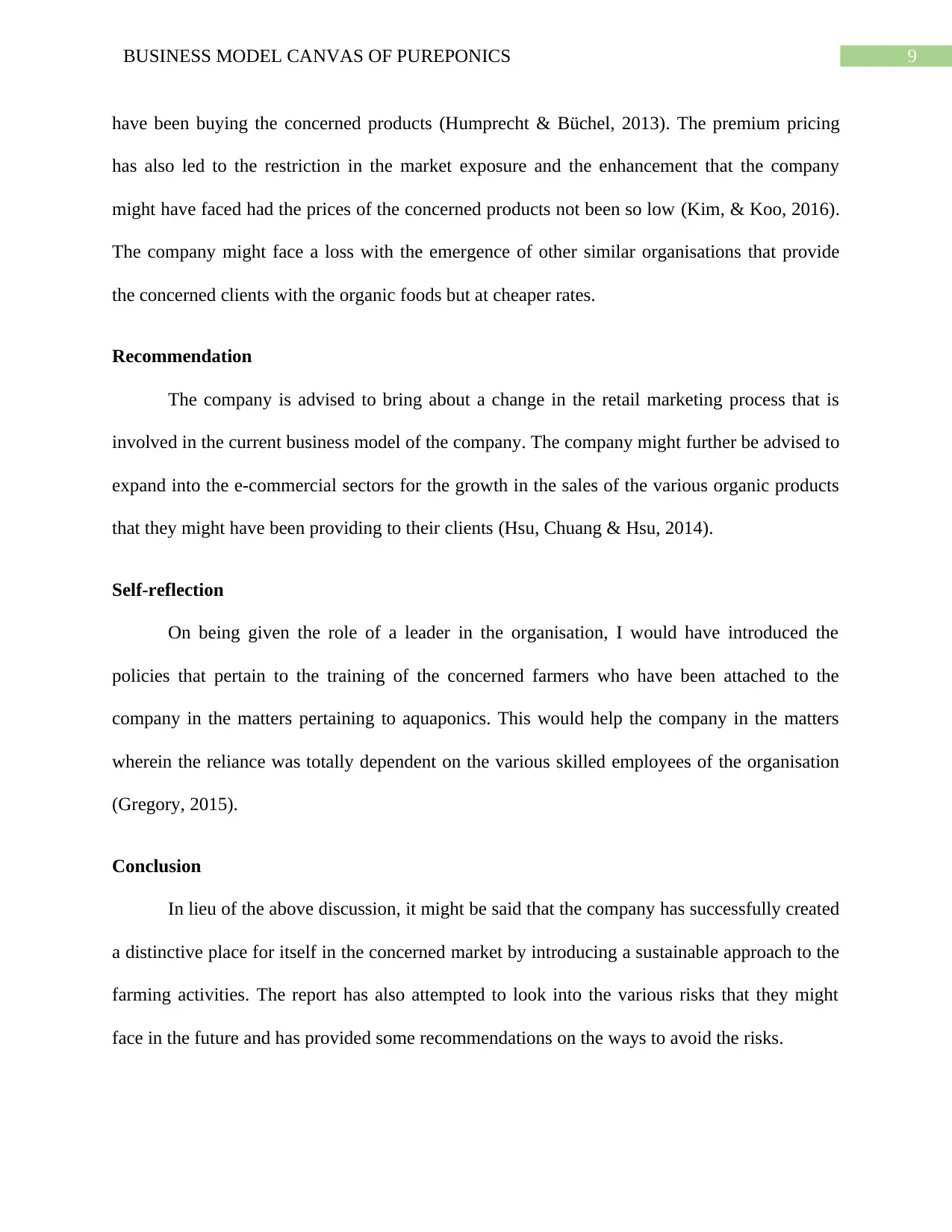
9BUSINESS MODEL CANVAS OF PUREPONICS
have been buying the concerned products (Humprecht & Büchel, 2013). The premium pricing
has also led to the restriction in the market exposure and the enhancement that the company
might have faced had the prices of the concerned products not been so low (Kim, & Koo, 2016).
The company might face a loss with the emergence of other similar organisations that provide
the concerned clients with the organic foods but at cheaper rates.
Recommendation
The company is advised to bring about a change in the retail marketing process that is
involved in the current business model of the company. The company might further be advised to
expand into the e-commercial sectors for the growth in the sales of the various organic products
that they might have been providing to their clients (Hsu, Chuang & Hsu, 2014).
Self-reflection
On being given the role of a leader in the organisation, I would have introduced the
policies that pertain to the training of the concerned farmers who have been attached to the
company in the matters pertaining to aquaponics. This would help the company in the matters
wherein the reliance was totally dependent on the various skilled employees of the organisation
(Gregory, 2015).
Conclusion
In lieu of the above discussion, it might be said that the company has successfully created
a distinctive place for itself in the concerned market by introducing a sustainable approach to the
farming activities. The report has also attempted to look into the various risks that they might
face in the future and has provided some recommendations on the ways to avoid the risks.
have been buying the concerned products (Humprecht & Büchel, 2013). The premium pricing
has also led to the restriction in the market exposure and the enhancement that the company
might have faced had the prices of the concerned products not been so low (Kim, & Koo, 2016).
The company might face a loss with the emergence of other similar organisations that provide
the concerned clients with the organic foods but at cheaper rates.
Recommendation
The company is advised to bring about a change in the retail marketing process that is
involved in the current business model of the company. The company might further be advised to
expand into the e-commercial sectors for the growth in the sales of the various organic products
that they might have been providing to their clients (Hsu, Chuang & Hsu, 2014).
Self-reflection
On being given the role of a leader in the organisation, I would have introduced the
policies that pertain to the training of the concerned farmers who have been attached to the
company in the matters pertaining to aquaponics. This would help the company in the matters
wherein the reliance was totally dependent on the various skilled employees of the organisation
(Gregory, 2015).
Conclusion
In lieu of the above discussion, it might be said that the company has successfully created
a distinctive place for itself in the concerned market by introducing a sustainable approach to the
farming activities. The report has also attempted to look into the various risks that they might
face in the future and has provided some recommendations on the ways to avoid the risks.
Paraphrase This Document
Need a fresh take? Get an instant paraphrase of this document with our AI Paraphraser
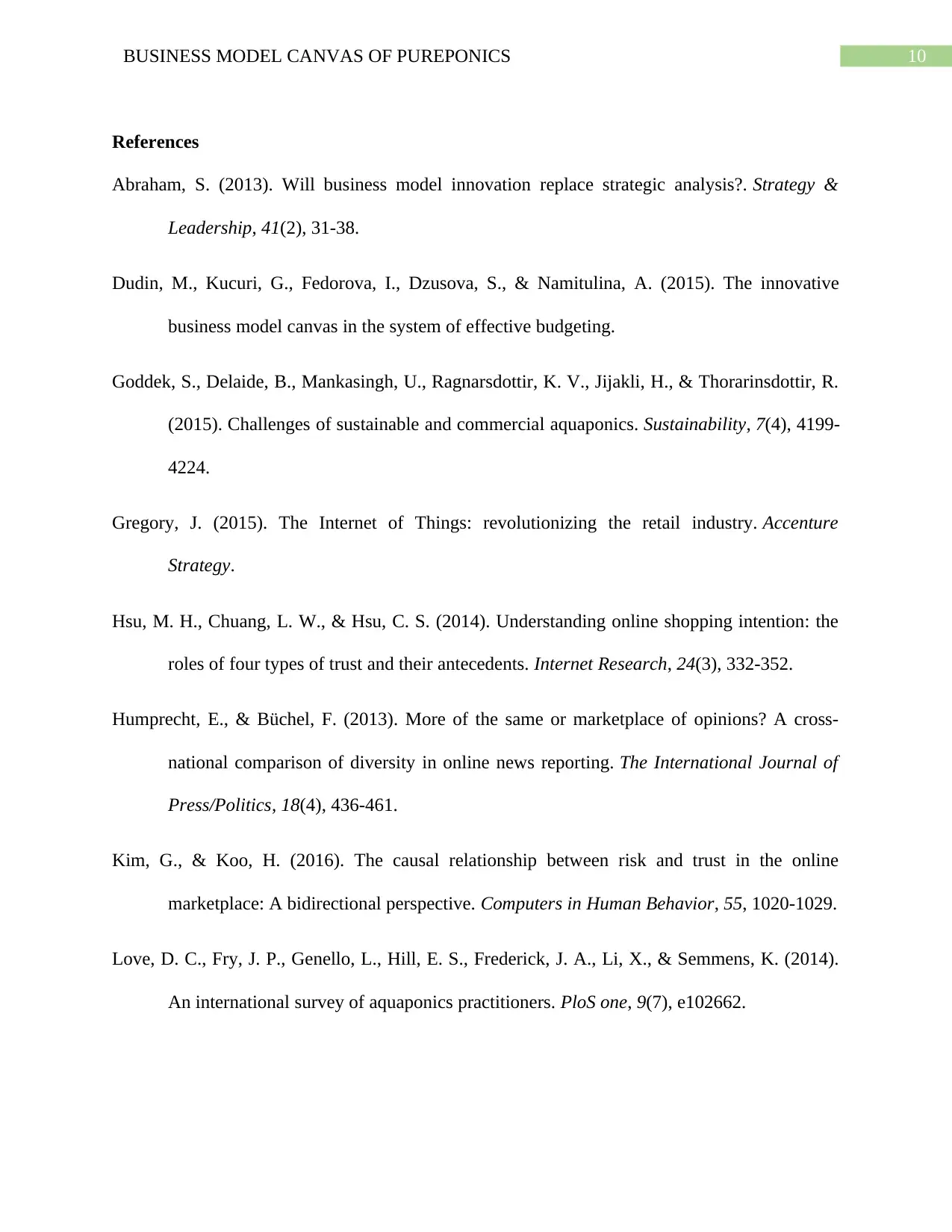
10BUSINESS MODEL CANVAS OF PUREPONICS
References
Abraham, S. (2013). Will business model innovation replace strategic analysis?. Strategy &
Leadership, 41(2), 31-38.
Dudin, M., Kucuri, G., Fedorova, I., Dzusova, S., & Namitulina, A. (2015). The innovative
business model canvas in the system of effective budgeting.
Goddek, S., Delaide, B., Mankasingh, U., Ragnarsdottir, K. V., Jijakli, H., & Thorarinsdottir, R.
(2015). Challenges of sustainable and commercial aquaponics. Sustainability, 7(4), 4199-
4224.
Gregory, J. (2015). The Internet of Things: revolutionizing the retail industry. Accenture
Strategy.
Hsu, M. H., Chuang, L. W., & Hsu, C. S. (2014). Understanding online shopping intention: the
roles of four types of trust and their antecedents. Internet Research, 24(3), 332-352.
Humprecht, E., & Büchel, F. (2013). More of the same or marketplace of opinions? A cross-
national comparison of diversity in online news reporting. The International Journal of
Press/Politics, 18(4), 436-461.
Kim, G., & Koo, H. (2016). The causal relationship between risk and trust in the online
marketplace: A bidirectional perspective. Computers in Human Behavior, 55, 1020-1029.
Love, D. C., Fry, J. P., Genello, L., Hill, E. S., Frederick, J. A., Li, X., & Semmens, K. (2014).
An international survey of aquaponics practitioners. PloS one, 9(7), e102662.
References
Abraham, S. (2013). Will business model innovation replace strategic analysis?. Strategy &
Leadership, 41(2), 31-38.
Dudin, M., Kucuri, G., Fedorova, I., Dzusova, S., & Namitulina, A. (2015). The innovative
business model canvas in the system of effective budgeting.
Goddek, S., Delaide, B., Mankasingh, U., Ragnarsdottir, K. V., Jijakli, H., & Thorarinsdottir, R.
(2015). Challenges of sustainable and commercial aquaponics. Sustainability, 7(4), 4199-
4224.
Gregory, J. (2015). The Internet of Things: revolutionizing the retail industry. Accenture
Strategy.
Hsu, M. H., Chuang, L. W., & Hsu, C. S. (2014). Understanding online shopping intention: the
roles of four types of trust and their antecedents. Internet Research, 24(3), 332-352.
Humprecht, E., & Büchel, F. (2013). More of the same or marketplace of opinions? A cross-
national comparison of diversity in online news reporting. The International Journal of
Press/Politics, 18(4), 436-461.
Kim, G., & Koo, H. (2016). The causal relationship between risk and trust in the online
marketplace: A bidirectional perspective. Computers in Human Behavior, 55, 1020-1029.
Love, D. C., Fry, J. P., Genello, L., Hill, E. S., Frederick, J. A., Li, X., & Semmens, K. (2014).
An international survey of aquaponics practitioners. PloS one, 9(7), e102662.
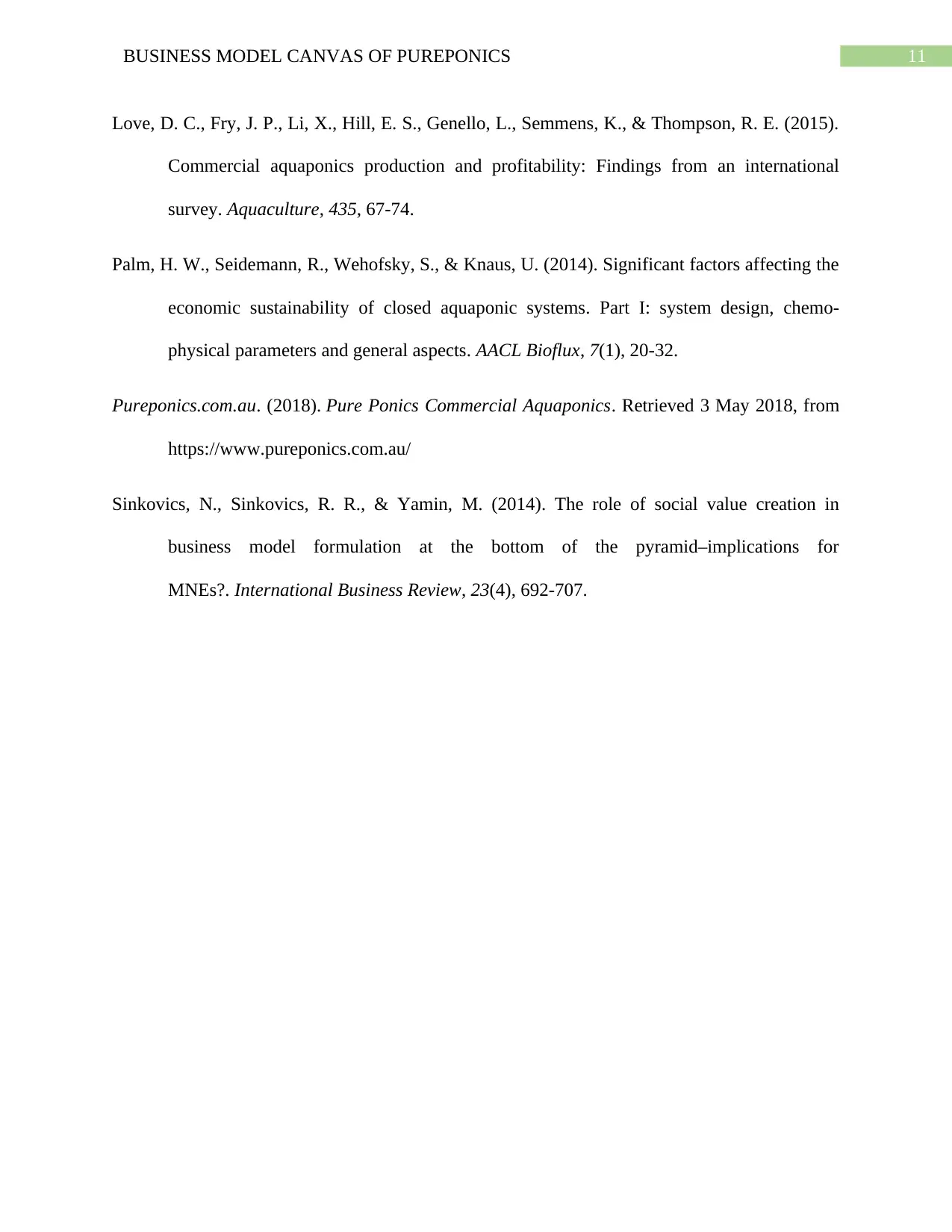
11BUSINESS MODEL CANVAS OF PUREPONICS
Love, D. C., Fry, J. P., Li, X., Hill, E. S., Genello, L., Semmens, K., & Thompson, R. E. (2015).
Commercial aquaponics production and profitability: Findings from an international
survey. Aquaculture, 435, 67-74.
Palm, H. W., Seidemann, R., Wehofsky, S., & Knaus, U. (2014). Significant factors affecting the
economic sustainability of closed aquaponic systems. Part I: system design, chemo-
physical parameters and general aspects. AACL Bioflux, 7(1), 20-32.
Pureponics.com.au. (2018). Pure Ponics Commercial Aquaponics. Retrieved 3 May 2018, from
https://www.pureponics.com.au/
Sinkovics, N., Sinkovics, R. R., & Yamin, M. (2014). The role of social value creation in
business model formulation at the bottom of the pyramid–implications for
MNEs?. International Business Review, 23(4), 692-707.
Love, D. C., Fry, J. P., Li, X., Hill, E. S., Genello, L., Semmens, K., & Thompson, R. E. (2015).
Commercial aquaponics production and profitability: Findings from an international
survey. Aquaculture, 435, 67-74.
Palm, H. W., Seidemann, R., Wehofsky, S., & Knaus, U. (2014). Significant factors affecting the
economic sustainability of closed aquaponic systems. Part I: system design, chemo-
physical parameters and general aspects. AACL Bioflux, 7(1), 20-32.
Pureponics.com.au. (2018). Pure Ponics Commercial Aquaponics. Retrieved 3 May 2018, from
https://www.pureponics.com.au/
Sinkovics, N., Sinkovics, R. R., & Yamin, M. (2014). The role of social value creation in
business model formulation at the bottom of the pyramid–implications for
MNEs?. International Business Review, 23(4), 692-707.
⊘ This is a preview!⊘
Do you want full access?
Subscribe today to unlock all pages.

Trusted by 1+ million students worldwide
1 out of 12
Related Documents
Your All-in-One AI-Powered Toolkit for Academic Success.
+13062052269
info@desklib.com
Available 24*7 on WhatsApp / Email
![[object Object]](/_next/static/media/star-bottom.7253800d.svg)
Unlock your academic potential
Copyright © 2020–2025 A2Z Services. All Rights Reserved. Developed and managed by ZUCOL.



